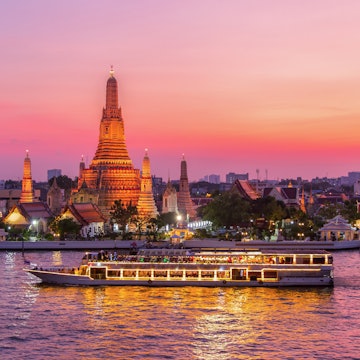

The ocean off the isle of Mauritius. Ohrim / Shutterstock
While booking a recent trip from the continental US to Hawaii – which required multiple flights that cost over $600 – I thought back to my first trip to Hawaii nearly 20 years ago when I paid barely half that price.
Travel price hikes happened slowly and then quickly over the past 20 years. According to the US Bureau of Labor Statistics, domestic airfare prices rose 34% between the end of 2020 and the beginning of 2025. And, of course, there are also the costs of food, lodging, activities and more to consider when you’re trying to drum up the courage (and the funding) to plan that long-awaited bucket-list vacation. So, with expenses stacking up before you even step on the plane, how on earth can you budget for that trip you’ve always dreamed of?
The good news: seasoned travelers and budget-savvy experts have more than a few clever tricks up their sleeves. From booking hacks to destination swaps, there are plenty of smart, strategic ways to stretch your budget – and even splurge a little – without sacrificing the magic of that trip on your bucket list.
Here’s how to start planning, without the sticker shock.

1. Prioritize, prioritize, prioritize
You can’t cut costs everywhere, so sit down in advance and determine your splurge vs. save areas. Sometimes, it’ll be an easy pick: if you’re spending a lot on a long-distance flight to the Maldives, commit to finding the cheapest food possible while you’re there. If you’re taking a road trip to a nearby US city, though, maybe you’ll have the cash on hand for a glam hotel or a few gourmet meals.
“Some people really don’t care too much about their lodging if they plan to spend their entire days out and about, so they are more than willing to skip the fancy hotels in favor of cheaper short-term rentals or even hostels,” says Steve Schwab of vacation rental company Casago. When you determine where you’re comfortable cutting costs, that gives you more funds for the parts of the trip you do want to prioritize.
2. Book smart: When you buy matters
Tim Hentschel of HotelPlanner always advises booking well in advance, meaning “as soon as a hotel, operator or airline’s future program goes on sale,” he says. “Booking short-haul flights five months in advance can save you just under 50% across flight and accommodation costs, whereas six months is recommended for long-haul, with further price reductions rising to 55%.” He adds that you should even go as far as to book all your flights and hotel reservations “for the entire calendar year as early as possible. This will not only ensure availability, but will act as a hedge against inflation and ongoing cost increases.”
But it’s not just general advance planning that matters; the day of the week you book that flight will affect your budget, too. Hentschell has some insider knowledge as to why: “Tuesdays are usually a good day to pick up a good holiday deal,” he explains. “Most often, the pricing teams for hotels and tour operators meet on a Monday to review what’s sold well over the weekend. Then, on Tuesday morning, they’ll update their systems and websites with deals and offers to increase bookings to hotels and destinations where they have more availability.” Booking on a Tuesday, he says, can drive savings of 8% for international travel especially.
Hentschel also recommends one of my own frequently used hacks: use the date-comparison price grid when booking flights. I just did this when booking summer 2025 flights from Nashville, Tennessee, to Montreal, Canada, and it became immediately clear that pushing my trip just one day later would cut the flight costs by more than half. Another tip is to conduct your booking during non-peak hours, “for example 6am or midnight on Saturday or Sunday, when there is less real-time competition” on booking sites, Hentschel adds.

3. Think outside the hotel box
Yes, luxury hotels are expensive, and if you want to live out your White Lotus dreams at the Four Seasons in Thailand, there’s not a ton you can do to cut costs there. But if you can be a bit flexible as to where you stay, there are plenty of ways to make visiting a dream destination more affordable, from house-sitting and home-swapping to hostels.
If you go the hostel route, “one of the best ways to stretch your budget further involves volunteering at your hostel in exchange for the cost of your stay,” recommends Dean Van Es of Fast Cover Travel Insurance. He has visited nearly 30 countries, many on a shoestring budget. “You might have to do the laundry or staff the check-in desk for a couple of hours, but the fact a major cost is taken care of means you have more to spend on life-changing experiences.”
Another creative lodging approach I love to use myself is doing a house-sit or house-swap. I use TrustedHousesitters for the former; with house-sitting, you take care of someone’s home (usually including plants and pets) while they’re away in exchange for a free stay. For the latter, I use HomeExchange, which lets you directly swap homes with someone (à la The Holiday) or even use points to visit at non-concurrent times. Note, though, that house-sitting can be considered “work” even though you aren’t earning money for it, so if you’re planning to do this abroad, make sure to research work visa requirements for your destination.

4. Use public transport when you can
If you’re staying in a city or traveling between towns in Europe, public transport is often the best and cheapest way to get around. “Rather than paying for expensive taxis between destinations, catching the bus or riding the train is bound to save you a significant expense,” says Van Es. And, bonus: traveling by public transport often gives you “another perspective on the country you’re visiting, making your experience even more fascinating,” Van Es concludes.
John Stepovy has intimate knowledge of this topic: he has worked for 15 years in the ground travel and mobility industry, including leadership roles in both public and private transit. He now works at Busbud, which helps millions of travelers book affordable intercity bus trips across more than 80 countries. “Many travelers overlook buses when planning bucket-list trips, but they’re often 5 to 10 times cheaper than flying or driving, especially in Europe and the Americas,” says Stepovy. “On Busbud, we’ve seen travelers save up to 85% by swapping regional flights for bus rides across Mexico, Canada and the US.”

5. Save with DIY and BYOB for dining
If you’re road tripping, “bring as many snacks/meals as you can,” advises Schwab, “and look into nearby markets or grocery stores to stock your mini fridge or kitchen area, especially if where you are staying doesn’t offer complimentary meals.” Plenty of us travelers have experienced how quickly restaurant costs can add up, especially if you end up eating out for three meals per day (which you’d never do at home, right?).
“If you can cut back on that as much as possible, even if that means just eating breakfast in your room each morning, that can make a huge difference,” says Schwab. So fill your hotel fridge with grocery store fruit, yogurt, granola and other favorites for the morning. For the evening, stock your own affordable wine if happy hour is on your agenda, and skip hefty craft cocktail costs at the hotel bar.
6. Don’t turn your nose up at free stuff
Ah, one of the classic travel traps of capitalism: the misconception that the most expensive attractions are the best ones. “There’s usually no shortage of landmarks that won’t cost you a cent,” says Van Es. “From wandering botanical gardens and open-air markets to exploring museum exhibitions, researching your destination’s top free activities will reduce pressure on your travel budget,” while still ensuring your itinerary is chock full of exciting experiences.

7. Maximize credit card points and miles
Yes, credit cards are a double-edged sword. If you already know you’re not great with debt, go ahead and skip this tip and just start saving to pay for your trip without using credit – because there’s nothing that jams up a future travel budget quite like credit card interest over time. But if you have good credit and are confident you can pay your cards off monthly in full, “make use of credit card programs and frequent flyer programs to minimize accommodation and flight expenses,” says Joe Cronin of International Citizens Insurance, who has spent more than 20 years helping expats and travelers make smart insurance decisions while moving and traveling abroad.
And look for opportunities to transfer points between cards, too: Melissa Cid, consumer savings expert for MySavings, says she saves thousands of dollars on airfare by transferring her credit card points from American Express and Chase cards to airline partner cards in order to book flights. “I fly my family to Europe in premium economy and business class for free, only paying taxes,” she says. “Depending on the airline and destination, taxes can be as low as $5 per person each way.”
She also recommends getting a new credit card when you’re offered a large sign-up bonus (again, only use these tips if you and debt are on good terms!). It’s “a great way to quickly accumulate points, which you can then convert into airline miles,” says Cid. This method “effectively decreases the amount you spend by hundreds of dollars,” agrees Cronin.
8. Pack wisely
I was heading on a European trip with my little sister Lily a few years back. She had never been, and I was excited to show her around my favorite haunts in Dublin and Paris. I had warned her: once we get to London, we’re flying RyanAir, and the baggage restrictions on that airline are tight. Did she listen (do little siblings ever)? Nope. Lily overpacked and was saddled with a nearly €150 ($US170) charge per flight for her baggage – more expensive than the flights themselves. So learn from dear Lily: save on baggage costs by packing smart and light.

9. Take advantage of these two words: Off season
My own #1 budget-travel tip is and has always been: peak season travel is overrated. Whether you’re dreaming about New Year’s Eve in Times Square or summer on Santorini, my best advice as a regular working gal who has managed to visit 40 countries is to break up with your season-specific vacation ideals and travel during off peak instead. From spending winter in wine country to exploring US national parks during the less popular shoulder season, simply choosing to travel during a destination’s least popular time of year can save you hundreds or even thousands of dollars.
But you don’t have to take my word for it. Founder of Dollar Flight Club Jesse Neugarten has helped more than 3 million people travel cheaper and agrees that “the best deals we’ve seen lately have been for shoulder season travel. Flights to Greece in May were under $450 roundtrip from the US. That same route jumps to $1,200 in July. Same goes for Spain and Italy; go a few weeks earlier or later than everyone else, and you’ll save big. Hotels and tours are also way more affordable outside of peak months.”
10. Embrace slow travel and living like a local
You may have heard of the slow food movement, but what about slow travel? “Devote your time to exploring one or two specific regions instead of rushing through five countries within seven days,” advises Nick Drewe, money-saving expert at Wethrift. “Your transportation costs will decrease while you gain authentic experiences through deep engagement with local culture and cuisine and offbeat attractions.”
One favorite travel activity of both Drewe’s and mine is doing a walking tour in a new city, many of which are even free. You should also check Reddit and local Facebook groups to discover hidden attractions and free activities that locals recommend where you are.














